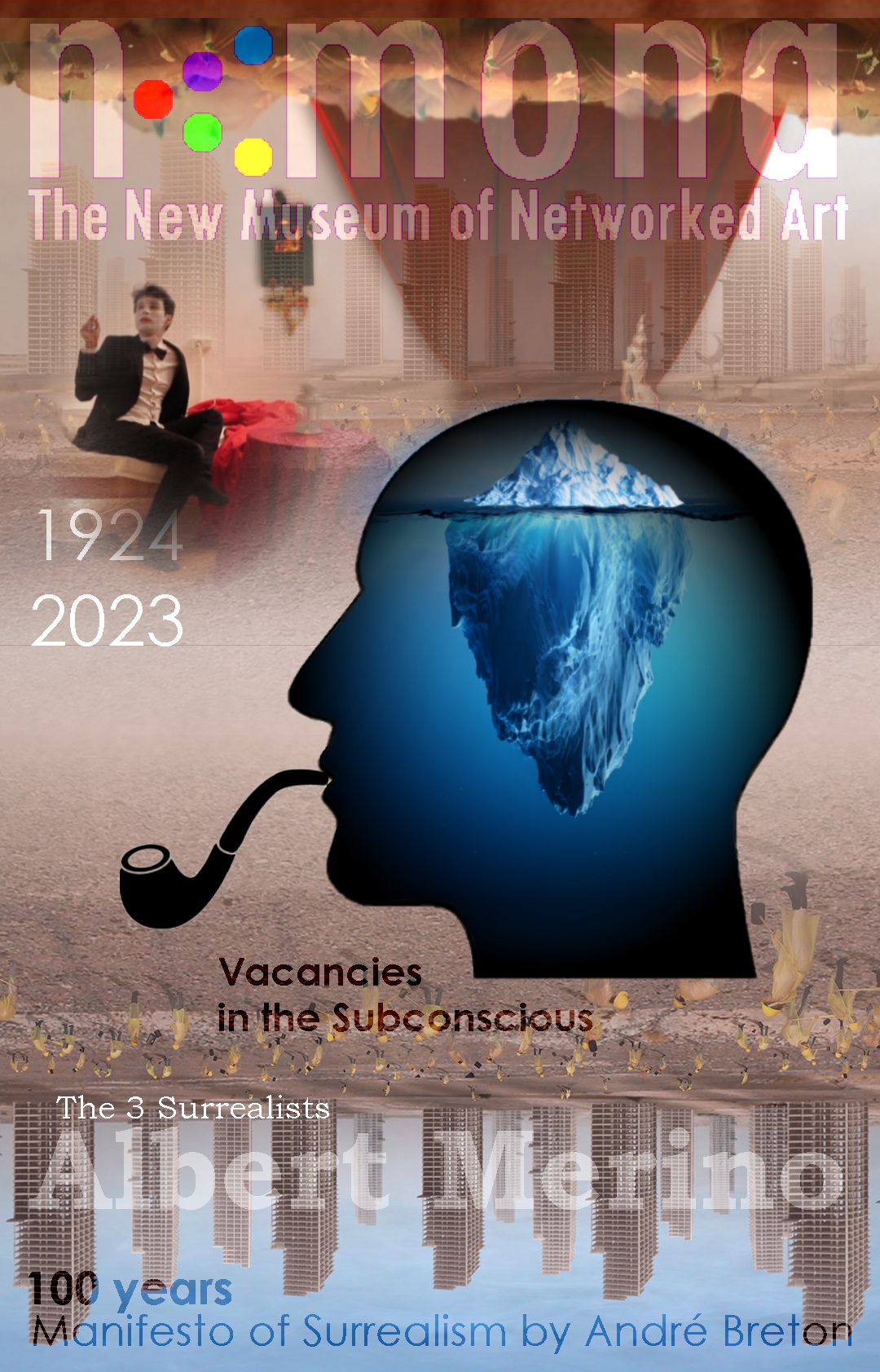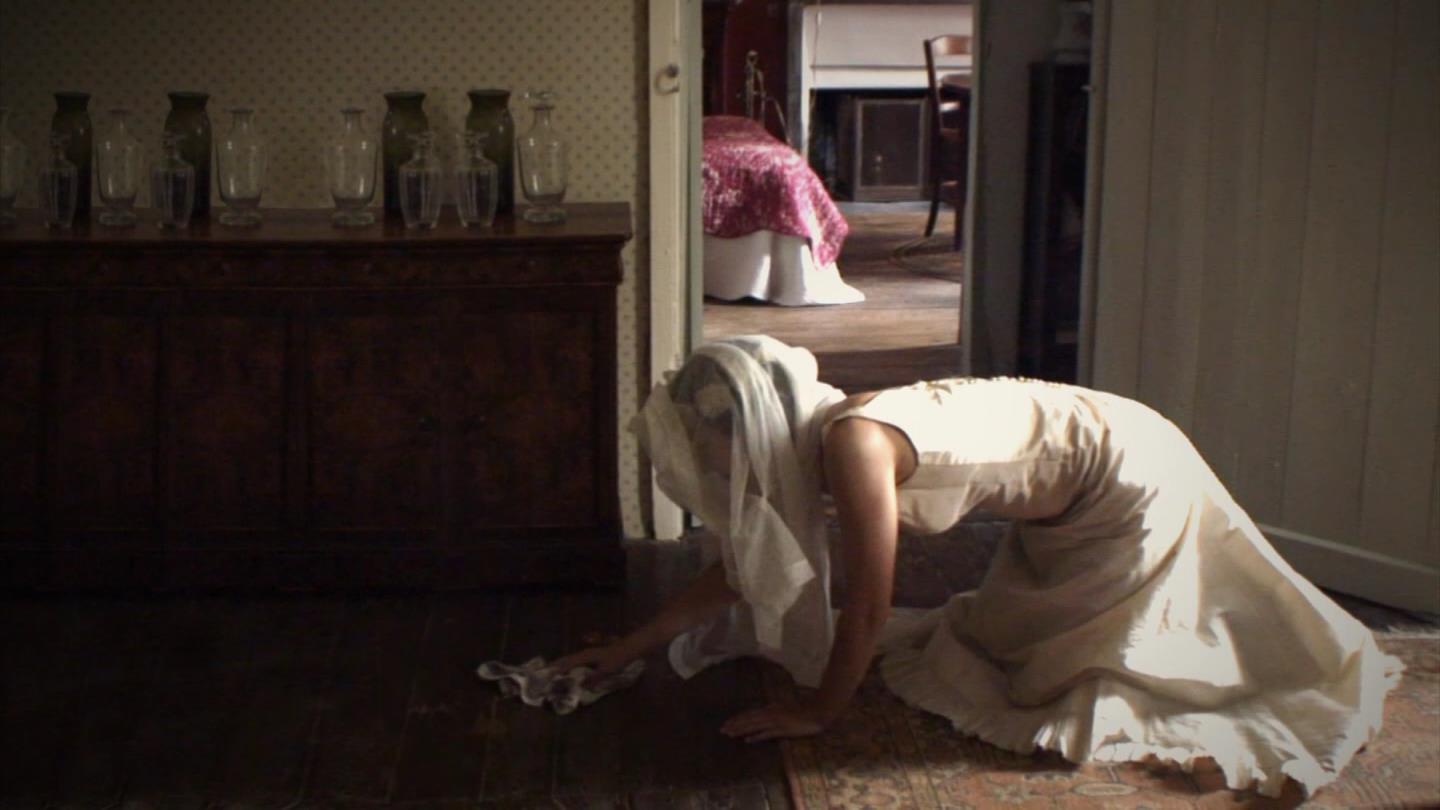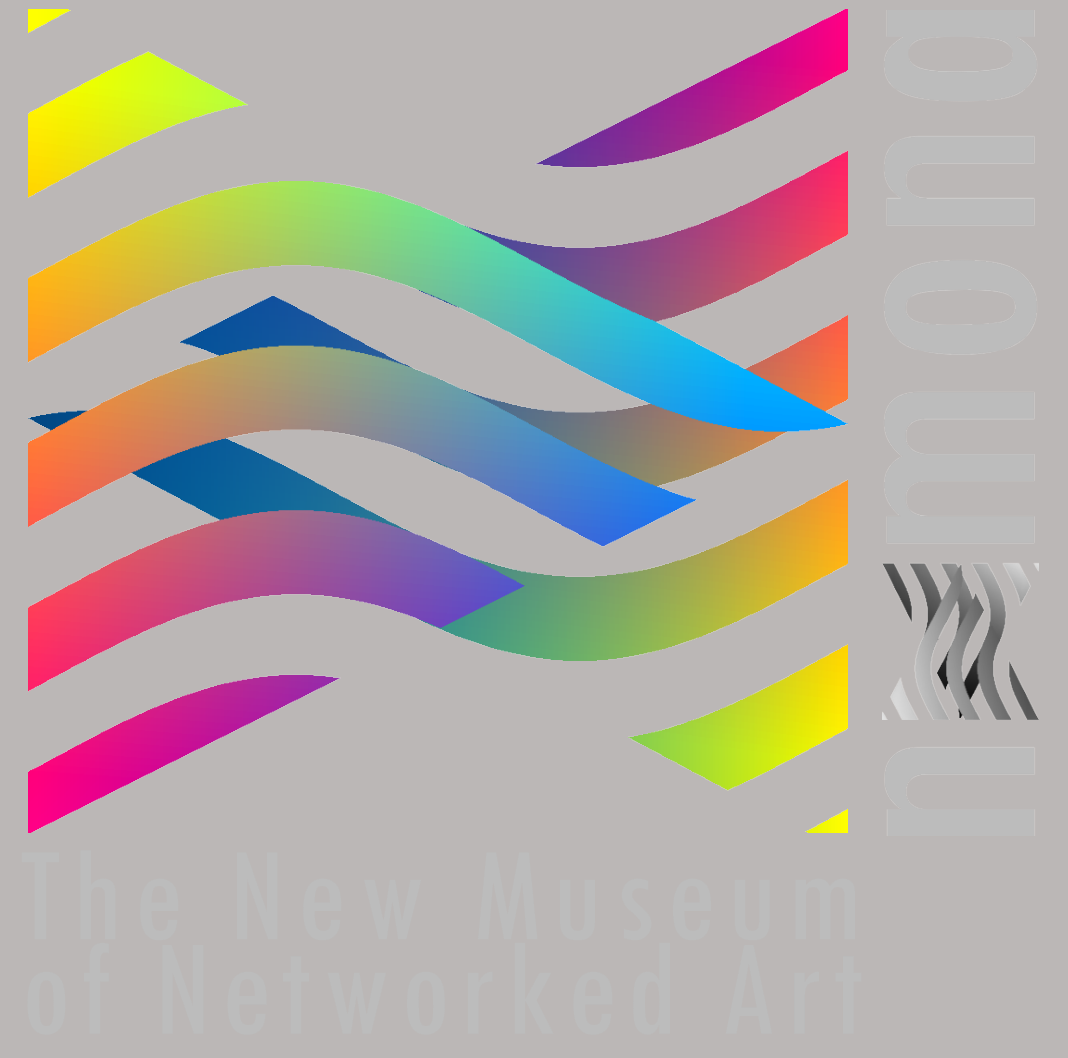






Open Call

Deadline 30 April 2023
Call for entries
In 1924, André Breton published the Manifesto of Surrealism, initiating one of the essential art movements of 20th century – the Surrealism. Although the art movement had its end in the sixties of 20th century, Surrealism survived because some essentials became a genetic code of contemporary art.
100 years later, The Motto of the Year 2023 – at The New Museum of Networked Art – is dedicated to this genetic code taking influence on videoart –
Vacations in the Subconscious
100 years – The Manifesto of Surrealism by André Breton.
The motto year started on 20 January 2023 at Hall of Fame @ Alphabet Art Centre with the key manifestation of – The 3 Surrealists – featuring three Spanish video artists – Albert Merino, Laura / Sira Cabrera and Ausín Sáinz – https://cinema.nmartproject.net/the-3-surrealists/ – including 10 videos by each artist, interviews, video statements – and contextual references.
It is planned to realize during the year 2023 at least four (4) video art programs based on an open call dedicated to the genetic code of Surrealism in art & moving images to be presented @ Alphabet Art Centre.
The open call is looking for videos using the medium – dealing with the diverse layers of reality and its alienation in an experimental, innovative, provocative, disturbing way.
Artists working with digital video are invited to submit max 3 videos in mp4 HD format – deadline 30 April 2023.
More details and entry form on
https://netex.nmartproject.net/?p=12106

The Motto Project of the Year 2023
to be launched in February 2023
Meanwhile, please visit the core of this project
The Three Surrealists @ Hall of Fame



The 3 Surrealists

Concept
The title of the video art project- “The 3 Surrealists” can be understood rather as a kind of provocation 100 years after André Breton, released his Manifesto of Surrealism in 1924.
As an art historical period of 20th century, the classical Surrealism had quite a short high time as a literary and artistic movement/ideology but its innovative language of form and representation at that time had lasting influence on the next following artists’ generations until today.
In this way, Surrealism did not only survive but became a kind of genetic code of/in contemporary art using the alienation of the existing/reality as a basic artistic principle/pictorial and compositional element.
Moving images/film became already in the early phases a medium for juxtaposing different types of realities, confronting the subjective, psychological condition of an individual with a more multifaceted reality of society.
Particularly the technological development of the digitalization since 2000 is allowing artists of all disciplines to create new realities of imagination generating not only visual, but general sensual sensations, including, like 100 years ago in Surrealism, that the effect as such is already misunderstood as an artistic expression.
While film/cinema had been a medium to be used from the beginning by some privileged people, it was this digitalization causing a democratization through the affordability/availability of the medium for all – video as a mass phenomenon and a favorite medium of artists.

The currently used artistic languages are the expression of this democratization, as well, the artists can draw from a wealth of possibilities.
Our three Spanish video artists Albert Merino, Laura / Sira Cabrera and Ausín Saínz are acting in this situational, historical, cultural and social context.
Although each of them is characterized by an artistic individuality generating a completely different creative output than the colleagues, all three have much in common – they follow an individual artistic concept based on criticism – on society – feminism – human rights – environment – climate change etc. They use – the technology in a exceptionally creative way, the different principles of alienation generating an individual cosmos of imagination/reality, and – by doing so they create what the Surrealists describe as dreamlike sequences hidden in the subconscious, they use different ways how communicate with the viewer.
In a certain way, all three are portraying themselves as a part of what is happening. While Ausín Saínz and the twins Laura/Sira Cabrera can be realized as acting persons/representatives of society, culture, environment – victims and perpetrators alike, Albert Merino’s metaphorical language does the same but more subtle, less obvious, his Compulsive Self-portrait is indicating, that he actually is playing the role of all the protagonists performing in his videos, as well, the different characters appearing in his videos compressed in one person. The individual artist is standing for mankind/society, and – the dangers the individual is confronted with and generating at the same time.

While Surrealism, like other art movements at their time had their roots in the turning point of society caused by the industrialization, as well as the traumatization of World War I, our three Spanish surrealists are not only standing at another human made turning point 100 hundred years later – the destruction of the natural environment, the climate change endangering life – the human, animal and plant species on planet Earth, and the effects on society and the individual, but reflect this turning point in most different ways by using a technology which is standing for another turning point – the digitalization in all areas of life causing a fundamental re-thinking of human values.
Re-thinking, that’s what Albert Merino’s , Laura / Sira Cabrera’s and Ausín Saínz’s artistic work is chracterizing, also re-thinking art as such. They are standing for the diversity of artistic individuality in video art /art video.
The 3 Surrealists project, featuring 10 videos by each artist created during the past 10 years would like to start a discussion about the point of view of contemporary art and moving images these days.

Surrealism is an art movement that emerged from Dadaism in 1920 and, influenced by psychoanalysis, aimed to make the contradictory experiences of dreams and reality tangible in an expanded consciousness as complex super-reality.
progenitors and roots
The unreal fantastic in the paintings of HIERONYMUS BOSCH and the dramatically staged visions of Mannerist painting in the 16th century are to be regarded as the forerunners and roots of Surrealism, which was formed in Paris from 1920 onwards.
Connected by the experiences of Dadaism and stimulated by SIGMUND FREUD’s insights into the effects of unconscious, psychological processes, a group of writers and artists formed, whose goals were first identified by GUILLAUME APOLLINAIRE (actually WILHELM APOLLINARIS DE KOSTROWITZKY, 1880-1918) with the term labeled “Surrealism”.
“Pittura Metafisica”
The painting of the Italian “Pittura Metafisica” (German: metaphysical painting), with which GIORGIO DE CHIRICO and CARLO CARRA (1881-1966) from 1917 onwards designed their psychological and philosophical perspectives in a traditional, painterly form, is considered to be the forerunner of Surrealism. They strived “to show the inner meaning, the higher reality beyond things”.
The preoccupation with the art of antiquity and the Renaissance formed the pool of her pictorial works, which are above all influenced by the motifs of the northern Italian city of Ferrara with its wide, empty squares, the statues and the monumental walls.
DE CHIRICO’s “The Disturbing Muses” and CARRA’s “Metaphysical Muse” (1917) address the culture of antiquity in a frozen alienation that seems petrified. Instead of the traditional admiration for beauty, the muses that once inspired thought appear only as abandoned, faceless, empty puppets, which in a perspectively stretched space like in the limelight on an abandoned theater stage seem to be only forgotten, motionless props . The magical isolation of things creates a sense of loneliness and mysterious disconnection. With a meditative turn to one’s own inwardness, the alogical composition of things leads to the question of a deeper meaning of existence lying behind experience and behind the superficial view.
The basic idea that behind the visible world there is an invisible world that can only be grasped in thought and that ranges from the often indescriptive laws of physics to the limits of metaphysical attempts at knowledge is at the beginning of all religion and philosophy.
dream interpretation
With his investigations, SIGMUND FREUD wanted to put the interpretation of dreams, which had influenced very concrete and politically highly significant decisions since antiquity, on a scientific basis.
Other states of consciousness could also be reached through hypnosis or drug use, which are experienced as an independent counter-world to material reality.
As early as the turn of the century, HENRI ROUSSEAU had depicted fascinating dream worlds with his large-format paintings as exotic visions in his seemingly naïve but very precisely executed paintings. The picture “The Dream” from 1910 with the red plush sofa in a green, impenetrable jungle seemed to TRISTAN TZARA to anticipate the “confrontation of alien realities on a picture surface”, which later had a strong influence on Surrealist art as a fundamental design technique of free association.
Dualism of dream and reality
The surrealists wanted to overcome the seemingly indissoluble dualism of dream and reality and, by combining the opposites, achieve a new, more complex and thus more far-reaching understanding of reality. The aim was to expand consciousness to a “surreal” view of things, i.e. one that goes beyond simple reality.
The Paris Surrealists, with ANDRE BRETON, LOUIS ARAGON (1897-1982), PHILIPPE SOUPAULT (1897-1990) and TRISTAN TZARA, were initially a literary movement and disseminated surrealist ideas in their magazine “Litterature”.
They were soon supported by the painters MARCEL DUCHAMP, MAN RAY, FRANCIS PICABIA and MAX ERNST (1891–1976), who organized their first joint exhibitions from 1925, which also included HANS ARP, PAUL KLEE, ANDRE MASSON (1896–1987), JOAN MIRÓ (1893-1983) and PABLO PICASSO participated.
MAX ERNST
In the picture “Au Rendez-vous des Amies” by MAX ERNST, the people depicted seem to float above the ground – as if carried by invisible forces – giving the picture an aura of the unreal that is no longer bound by the laws of gravity seems to be.
In Joan Miró’s pictures, the attempt to reproduce the immediate pictorial nature of thinking becomes clear. The picture “The Wine Bottle” from 1924 is no longer a mirror of the external world of things, but becomes a new reality in which the familiar objects are only contained symbolically – like alienated signs. MAX ERNST primarily developed his own technical processes in the production of images in order to eliminate the conscious, creative will.
In 1925 he discovered “Frottage” as a suitable method for a quasi-automatic design process. The “Grattage” process expands these possibilities by placing a canvas painted with different layers of paint over relief-like objects so that their structures produce an imprint in the colors. When the colors have dried, they are partially scraped off, revealing the deeper layers.
Finally, MAX ERNST also used “décalcomanie”, a technique for peeling off pictures developed by OSCAR DOMINGUEZ (1906–1957). If paper or canvas is placed on a glass plate that has been freshly oiled, organic-looking structures are created when it is peeled off, which greatly expands the design options. ERNST has also been involved with sculpture since the 1940s. For his home in Sedona, Arizona, he created the watchman group “Capricorn”.
SALVADORE DALÍ
(1904–1989) subjected the course of automatically generated psychological processes to conscious control. He developed his “paranoid-critical method” from the stream of inner mental images that he experienced in trance-like states.
Paranoia is a mental illness characterized by chronic delusions. The paranoid feels and sees everything very clearly, he sees more than in the normal state and thus achieves an expansion of his consciousness beyond the limits of simple reality.
The absurd constellations in which the actually familiar things appear show the unbridgeable and tormenting contradiction between rationality and irrationality in “Surrealism”. The chasm between the uninhibited world of drives and social ties becomes a tragic split in the human spirit, destroying or denying all optimistic notions of harmony between reason and feeling.
In the picture “The Permanence of Memory” DALÍ depicts a changed, subjective perception of time. The shape of the soft clocks, which is said to have been inspired by the shape of soft, melted Camembert cheese, refers to the transience and relativity of time . The melting head with the closed eye is exposed to the process of death and decay in a vast, lonely landscape.
However, the delusional imaginary images are not just products of an overstimulated imagination, but – as picture puzzles and optical illusions clearly show – are latently contained in every simple, completely normal process of perception. Dali worked on these phenomena of active and selective perception in a series of pictures which, like a picture puzzle, only reveal their multidimensionality after prolonged, concentrated or meditative viewing.
RENE MAGRITTE
The painter RENÈ MAGRITTE (1898-1967) developed a method with a precise painting style that seems almost naïve in detail, which tries not to depict the processes of thought, but to make them directly comprehensible. The splitting of identity between an object and its usual representation through images and words challenges the interpretive thinking of the viewer. The alogical composition of things and the separation of appearance and concept opens up a magical, but at the same time critical, dimension of thinking that prompts reflection on one’s own mental activity.

Laura y Sira Cabrera (Spain)

Laura Cabrera Díaz and Sira Cabrera Díaz
are born in Spain. They have a degree in Fine Arts from the Complutense University of Madrid. And there have been exhibitions of painting, sculpture and engraving. Since 2009, they have created 35 pieces of video art and have participated in more than 100 international video art festivals.
The video titles
Laura y Sira Cabrera (Spain) – Self-Abandonment, 2012, 3:23
Laura y Sira Cabrera (Spain) – The Body Screams, 2012, 7:36
Laura & Sira Cabrera (Spain) – Between Species, 2021, 9:16
Laura & Sira Cabrera (Spain) – Climate Spasms, 2020, 6:23
Laura & Sira Cabrera (Spain) – Monologue, 2020, 1:09
Laura & Sira Cabrera (Spain) – Woman Deleted II , 2015, 3:21
Laura & Sira Cabrera (Spain) – Be/Being , 2019, 7:53
Laura & Sira Cabrera (Spain) – Transmutations, 2018, 10:12
Laura & Sira Cabrera (Spain) – Indicios / Inkling, 2017, 6:59
Laura & Sira Cabrera (Spain) – Virulencia, 2020, 5:05









Albert Merino (Spain)

Albert Merino (Barcelona 1979) is a videoartist. He was graduated in Fine arts by the University of Barcelona and the Kunsthochshule Berlin Weißensee.
He lived in the cities of Barcelona, Berlin and Paris where he produced a series of video works portraying different aspects of the city and developing a broad imagi- nary, using the video as a tool to intervene on the ordinariness and to materialize imaginary scenes or Utopias. There uses a wide range of records, that go from the author’s pieces with one more character intimist one up to the videodance or the fictional documentary. He has being doing as well different video collaborations with different plastic artists or theatre groups as Fluchtkunst for the set designer Joachim Dam, the ‘Fura dels Baus’ or the performer Empara Roselló. From his carrer is worth highlighting the solo exhibitions ‘La esencia de la piedra’ (2013) espacio Trapezio Madrid, or ‚La sombra de Lot’ (2012) capilla del pronillo, Santander, and the solo projections in the Art Center, Arts Santa Mónica of Barce- lona (Flux 2011/2013) and the Ateneu Barcelonés.
His work is part of private art collections in several countries and has been pre- sented in Art Fairs as Estampa (2008/13), Los Angeles Art Fair (2011) or Beijing Art Fair (2013)
The video titles
Albert Merino (Spain) – The City and The Other, 2010, 3:09
Albert Merino (Spain) – Hidden Mud, 2010, 7:42
Albert Merino (Spain) – Les Bagneurs, 2010, 3:50
Albert Merino (Spain) – The White Rain, 2010, 8:10
Albert Merino (Spain) – The Trace of Salt, 2010, 7:38
Albert Merino (Spain) – Le Badinage, 2010, 6:32
Albert Merino (Spain) – Lot’s Shadow, 2011, 6:40
Albert Merino (Spain) – Compulsive Self-portrait, 2011,05:46
Albert Merino (Spain) – Memories of Detachment, 2021, 18:00
Albert Merino (Spain) – Bestiary, 2018, 5:10
Albert Merino (Spain) – The Present Condition, 2020, 18:18









Ausin Sáinz (Spain)

Ausín Sáinz – Trained at the Faculty of Fine Arts in Salamanca where he completed the specialties of Painting, Sculpture, Graphic Design and Audiovisual Communication, Ausín Sáinz has come a long way from his beginnings to his latest video creations and urban installations. His work, with its figurative and baroque aesthetics, disturbing and not at all accommodating, has been seen in numerous spaces both
in Spain and in other countries.
The video titles
Ausin Sainz (Spain) – Peaceful Protest,, 2020, 5:00
Ausin Sainz (Spain) – Walls, 2020, 8:17
Ausin Sainz (Spain) – Today, 2019, 5:00
Ausin Sainz (Spain) – Infecto, 2016, 2:55
Ausin Sainz (Spain) – Security, 2015, 06:25
Ausin Sainz (Spain) – Passport, 2015, 04:36
Ausin Sainz (Spain) – Fidelity, 2015, 6:12
Ausin Sainz (Spain) – Dictator,. 2014, 03:47
Ausin Sainz (Spain) – The Unborn, 2014, 4:43
Ausin Sáinz (Spain) – Spain Catalonia_Russia, 2022, 07:48










Credits




The show “The 3 Surrealists” is a collaboration / networked action between
THe New Museum od Networked Art,
the curator Wilfried Agricola de Cologne (Cologne/Germany) and the artists Laura & Sira Cabrera, Albert Merino and Ausín Saínz @ Alphabet Art Centre.
All texts, images and videos © by the artists/authors/curator or owners.
The Online/Offline Show – “The 3 Surrealists”, its concept, design and work out © 2023 by Agricola de Cologne/The New Museum of Networked Art.










